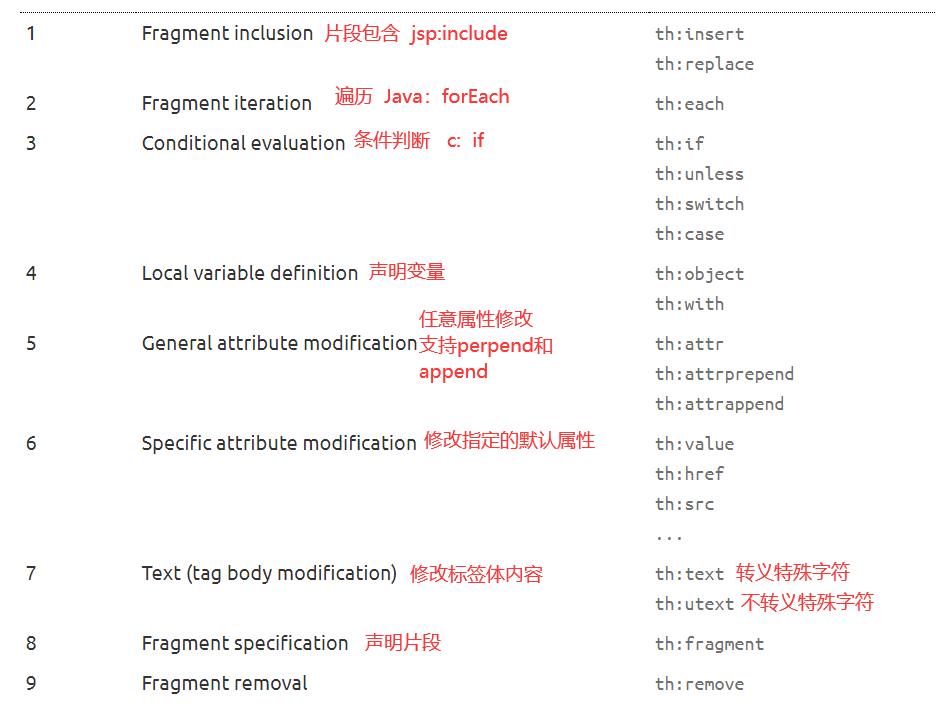SpringBoot的web开发
Posted 杨治中
tags:
篇首语:本文由小常识网(cha138.com)小编为大家整理,主要介绍了SpringBoot的web开发相关的知识,希望对你有一定的参考价值。
简介
Web开发的核心内容主要包括内嵌的Servlet容器和SpringMVC。
SpringBoot使用起来非常简洁,大部分配置都有SpringBoot自动装配。
SpringBoot的web支持
SpringBoot提供了spring-boot-starter-web为web开发予以支持,而这个启动器内嵌了Tomcat以及SpringMVC依赖。而web相关的自动配置存储在spring-boot-autoconfigure.jar的org.springframework.boot.autoconfigure.web包下。
其中如图:

从这些文件名就可以看出:
ServletWebServerFactoryAutoConfiguration和ServerProperties自动配置内嵌的Servlet容器
HttpEncodingAutoConfiguration和ServerProperties自动配置http编码
MultipartAutoConfiguration和MultipartProperties自动配置上传文件属性
WebMvcAutoConfiguration和WebMvcProperties配置Spring MVC
Thymeleaf,模板引擎
SpringBoot中推荐使用Thymeleaf,是因为Thymeleaf提供了完美的SpringMVC支持。
基础
Thymeleaf是一个Java类库,让是一个xml/xhtml/html5的模板引擎,可以作为MVC的View层。
Thymeleaf还提供了额外的模块与SpringMVC集成。
Thymeleaf的自动配置规则:ThymeleafProperties
@ConfigurationProperties(prefix = "spring.thymeleaf")
public class ThymeleafProperties
private static final Charset DEFAULT_ENCODING;
public static final String DEFAULT_PREFIX = "classpath:/templates/";
public static final String DEFAULT_SUFFIX = ".html";
private boolean checkTemplate = true;
private boolean checkTemplateLocation = true;
private String prefix = "classpath:/templates/";
private String suffix = ".html";
private String mode = "HTML";
private Charset encoding;
可以看到其中默认的前缀和后缀,所以只需要把html页面放在templates下,thymeleaf就会自动渲染。
模板引擎的作用
做好一个前端页面模板,其中包含一些动态的值,我们写一些表达式代替。而这些值,是从后台获取的已经封装好的数据。然后把这个页面模板和数据交给模板引擎,模板引擎按照数据帮我们解析表达式、并把结果填充到指定的位置,然后把这个数据最终生成一个想要的内容输出到前端页面,这就是我们这个模板引擎,不管是jsp还是其他模板引擎,都是这个思想。只不过,不同模板引擎之间,语法不同。
Thymeleaf模板引擎,是一个高级语言的模板引擎,语法更简单,功能更强大。
使用Thymeleaf模板引擎
引入Thymeleaf并在html页面添加命名空间约束
<!--thymeleaf-->
<dependency>
<groupId>org.springframework.boot</groupId>
<artifactId>spring-boot-starter-thymeleaf</artifactId>
</dependency>
xmlns:th="http://www.thymeleaf.org"
Thymeleaf语法
参考Thymeleaf 官网
我们可以使用任意的th:xxx来替代html中原生属性的值

常见的表达式语法
Simple expressions:(表达式语法)
Variable Expressions: $...:获取变量值
Selection Variable Expressions: *...:选择表达式:和$在功能上是一样;
Message Expressions: #...:获取国际化内容
Link URL Expressions: @...:定义URL;
Fragment Expressions: ~...:片段引用表达式
Literals(字面量)
Text literals: 'one text' , 'Another one!' ,…
Number literals: 0 , 34 , 3.0 , 12.3 ,…
Boolean literals: true , false
Null literal: null
Literal tokens: one , sometext , main ,…
Text operations:(文本操作)
String concatenation: +
Literal substitutions: |The name is $name|
Arithmetic operations:(数学运算)
Binary operators: + , - , * , / , %
Minus sign (unary operator): -
Boolean operations:(布尔运算)
Binary operators: and , or
Boolean negation (unary operator): ! , not
Comparisons and equality:(比较运算)
Comparators: > , < , >= , <= ( gt , lt , ge , le )
Equality operators: == , != ( eq , ne )
Conditional operators:条件运算(三元运算符)
If-then: (if) ? (then)
If-then-else: (if) ? (then) : (else)
Default: (value) ?: (defaultvalue)
Special tokens:
No-Operation: _
使用SpringBoot的步骤
创建一个SpringBoot项目,选择需要的模块,SpringBoot默认将选择的模块自动配置。
手动配置文件中的配置部分。
更加专注编写业务代码,不需要考虑之前的一大堆配置。
静态资源的自动配置
在自动配置类WebMvcAutoConfigurationAdapter的addResourceHandlers方法中 定义了以下静态资源的自动配置。
1. 类文件路径
把类路径向下的/META-INF/resources,/resources,/static和/public文件夹下的静态文件直接映射为/**,可以通过http://localhost:8080/**来访问
2. webjar
何谓webjar,webjar就是将我们常用的脚本框架封装在jar包中的jar包
webjar官网
把webjar的/META-INF/resources/webjars/下的静态资源文件映射成/webjar/**,可以通过http://localhost:8080/webjar/**来访问
"classpath:/META-INF/resources/" localhost:8080/webjars/
"classpath:/resources/" //优先级最高 localhost:8080/
"classpath:/static/" //优先级其次,默认 localhost:8080/
"classpath:/public/" //优先级最低 localhost:8080/
 阅读世界,共赴山海
阅读世界,共赴山海
 423全民读书节,邀你共读
423全民读书节,邀你共读
以上是关于SpringBoot的web开发的主要内容,如果未能解决你的问题,请参考以下文章